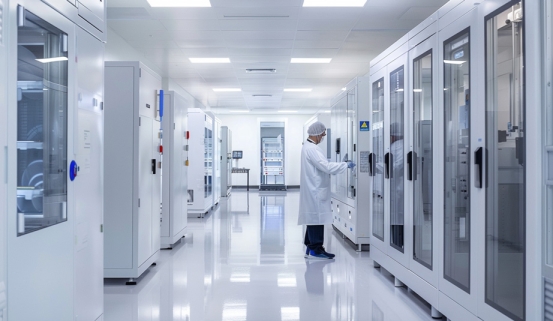

In fields where a single dust particle can disrupt production, cleanroom services are indispensable. From pharmaceutical labs and semiconductor plants to aerospace assembly lines, these meticulously engineered spaces are designed to maintain strict conditions. With advanced filtration systems and disciplined protocols, cleanrooms protect air purity, minimize contamination, and uphold the demanding quality standards of modern industries.
In fields where a single dust particle can disrupt production, cleanroom services are indispensable. From pharmaceutical labs and semiconductor plants to aerospace assembly lines, these meticulously engineered spaces are designed to maintain strict conditions. With advanced filtration systems and disciplined protocols, cleanrooms protect air purity, minimize contamination, and uphold the demanding quality standards of modern industries.

Cleanroom services involve professional cleaning, monitoring, and maintenance of environments where air quality and particle control are critical. These services are essential across sectors where even microscopic impurities can compromise safety or performance.
By adhering to international benchmarks like ISO classifications, technicians apply specialized cleaning agents, use dedicated tools, and employ rigorous procedures to ensure surfaces and air remain particle-free. Beyond cleaning, airflow management and filtration systems play a central role in sustaining the controlled environment.
Cleanroom standards exist to eliminate the risk of contamination that could derail production or endanger health. In microelectronics, tiny particles can damage circuits, while in biotechnology, contamination can undermine product safety.
Maintaining compliance not only safeguards product integrity but also reduces costly recalls, strengthens regulatory approval, and protects an organization’s reputation. Simply put, these standards are the backbone of trust in high-stakes industries.
Cleanrooms are categorized under ISO standards, which define acceptable particle concentrations per cubic meter. Ranging from ISO Class 1 (ultra-stringent) to ISO Class 9 (less demanding), each type carries unique requirements.
Semiconductor facilities – demand near-total elimination of microscopic contaminants.
Pharmaceutical operations – focus on sterility to protect patients and ensure drug efficacy.
Aerospace and defense labs – require precise assembly in environments free of airborne interference.
Choosing the right class of cleanroom ensures the correct balance between cleanliness, cost, and industry need.
Effective cleanroom performance depends on multiple integrated systems:
Filtration – HEPA and ULPA filters remove airborne particles.
Airflow control – regulates pressure, humidity, and temperature to prevent contamination spread.
Surface cleaning – specialized wipes and solutions prevent residue buildup.
Monitoring – sensors and particle counters ensure compliance in real time.
Regular calibration, inspections, and documentation reinforce accuracy and reliability.
Cleanroom cleaning involves a precise step-by-step approach. Dry particle removal is followed by wet wiping with low-residue agents. Some industries require ionized water rinses or antimicrobial solutions to achieve sterilization.
Disposable wipes, mops, and garments are standard to prevent cross-contamination. Both manual methods and automated cleaning systems are used, supported by strict checklists to guarantee thorough coverage.
Personnel are a critical factor in cleanroom performance. Workers undergo training in gowning techniques, entry/exit routines, and contamination prevention. Handling of chemical agents and proper use of PPE are emphasized to protect both workers and the environment.
Regular refresher courses and certification renewals ensure staff remain compliant with evolving standards and technologies.
Cleanroom operations are central to:
Semiconductor production – where defects from dust can destroy microchips.
Pharmaceuticals and medical devices – where sterility impacts patient safety.
Aerospace and defense – where precision components require controlled assembly.
Research laboratories – where consistent environmental conditions support accurate results.
Technology is enhancing cleanroom efficiency and reliability. Examples include:
ULPA filters – surpassing HEPA in particle capture efficiency.
IoT monitoring systems – offering 24/7 oversight with automated alerts.
Robotics – reducing human presence and error in repetitive cleaning tasks.
Antimicrobial surfaces – lowering the frequency of deep-clean cycles.
Meeting international regulations like ISO and GMP is vital for credibility. Routine inspections, performance audits, and detailed record-keeping verify that facilities remain compliant.
Proper documentation of cleaning schedules, monitoring data, and staff training also helps during audits and ensures operational authorization.
As industries advance, cleanroom services will focus more on sustainability and automation. Eco-friendly cleaning agents, energy-efficient airflow systems, AI-driven predictive maintenance, and autonomous cleaning robots are set to reshape the field.
By combining human expertise with technology, future cleanrooms will not only maintain ultra-clean standards but also operate more sustainably and cost-effectively.
Cleanroom services are the backbone of industries where precision and purity are non-negotiable. Through advanced systems, rigorous compliance, and emerging innovations, they ensure that businesses deliver safe, reliable, and high-quality outcomes in an increasingly demanding world.